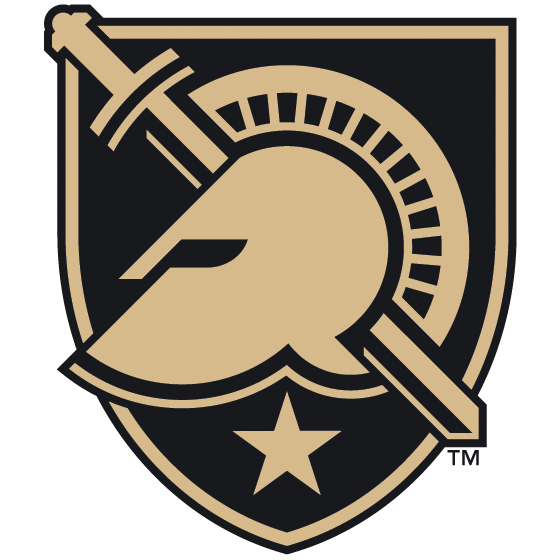WEST POINT, N.Y. – Army West Point Athletics today introduced a new brand and identity system that sets the visual direction for years to come. The updated identity provides a fresh look at one of the most storied brands in all of intercollegiate athletics.
The new brand was unveiled Monday night at Eisenhower Hall in front of the Corps of Cadets.
Army West Point Athletics and Nike collaborated on an 18-month brand evolution program to enhance and perfect upon the celebrated marks of the United States Military Academy, honoring the duty, leadership and rich history of academics and athletics, key characteristics and attributes associated with the Academy. With the goal of engaging new cadets, faculty and staff as well as building upon its remarkable reputation as America’s Academy, developing a seamless and consistent athletic identity is paramount.
Army West Point and Nike worked with U.S. Army and Academy leadership, current and former cadet-athletes, coaches, historians and West Point graduates to pay tribute to the Academy’s legacy and tradition. The finished product is a patriotic journey that plays off the brand attributes of Army West Point. As part of the updated brand identity, all 28 of Army West Point Athletics intercollegiate sports teams will showcase consistent logos, colors, lettering and numerals that will debut with the football and fall sports programs and eventually expand across all sports in the upcoming seasons.
“To separate the Army from West Point is to take away the purpose of the United States Military Academy,” said Lt. Gen. Robert Caslen, Jr., USMA superintendent. “Since its founding in 1802, West Point has produced soldier-scholars and leaders of character for America. This innovative new branding respects and elevates the Academy’s history and heritage and reflects the unique qualities of Army West Point Athletics, while tying the service to the Academy.”
Said Army West Point Director of Intercollegiate Athletics Boo Corrigan, “We are very proud to showcase our new athletic marks. When we started this 18-month process, our goal was to better position the Academy nationally with consistent logos, colors, lettering and numerals that tell the story of the Academy and our cadets. It was very important to us that this process was collaborative, which is why we involved a host of constituent groups, including U.S. Army and Academy leadership, current and former cadet-athletes, coaches, historians and West Point graduates. I would personally like to thank the committee that worked directly with Nike in helping to make this process a reality. We believe that we achieved our goal and are excited about the future of Army West Point Athletics.”
The Army West Point primary mark perfectly portrays the soldier-scholar ideal. Athena’s Helmet symbolizes wisdom while the sword represents the warrior ready for battle.
In an effort to create consistency across all applications that honors the past while attracting new audiences in an authentic and meaningful way, there will be a brand-new primary logo that pays homage to the Academy and what it stands for. The Athena Shield is indisputably iconic and unique to Army West Point Athletics. It signals a consistent foundation that honors the brand equity that has been built across centuries of service, competition and sacrifice while creating distinction and reinforcing the Army West Point Brand for the next generation. The Athena Shield is comprised of four unique elements (the shield, helmet, sword and star) that come together to represent Army West Point Athletics with power and authenticity.
The primary color palette contains Army Black, USMA Gold, Gray and White. It will serve as the primary palette, used on most brand applications. This is a color palette that is authentic to military history, finishes and materials. These colors represent the future of West Point and the larger Army organization. The primary color palette also draws inspiration from the components of gunpowder, the current Army Combat Uniform (ACU) and the Long Gray Line.
“It’s an incredible opportunity for us to work hand-in-hand with such a storied institution,” said Todd Van Horne, vice president and creative director for Nike Football and Baseball. “The new embellishments are a small token to the service and sacrifice that everyone involved at Army West Point has made for this Country.”
As part of the new program, all 28 of Army West Point Athletics intercollegiate sports teams will showcase consistent logos, colors, lettering and numerals.
While a new primary logo has been established, Army West Point will continue to use Black Knights as a nickname.
Fans can go to nike.com or goarmywestpoint.com for immediate purchases or pre-sale ordering. Most retail outlets that sell Army West Point merchandise will have products with the new branding by the end of April.
NEW ARMY BRAND IDENTITY STANDARDS
Introduction to the moniker Army West Point
Introduction of a new primary logo, the Athena Shield to be used consistently by all intercollegiate athletic teams.
Custom alphabet, logotypes and numeral set.
Primary and secondary color palettes.
Army West Point
The U.S. Army and West Point are indivisible. To separate the Army from West Point is to take away the purpose of the United States Military Academy. Since its founding in 1802, West Point has produced soldier scholars for America. The best education in the nation hones the intellect, while the tough physical and military training creates the warrior.
The Army West Point primary mark perfectly portrays the soldier scholar ideal. Athena’s helmet symbolizes wisdom while the sword represents the warrior ready for battle. Soldier Scholar. Army West Point.
Primary Identity – The “Athena Shield” Logo
The Athena Shield is indisputably iconic and unique to Army West Point Athletics. It signals a consistent foundation that honors the brand equity that has been built across centuries of service, competition and sacrifice while creating distinction and reinforcing the Army West Point brand for the next generation.
The Athena Shield is comprised of four unique elements that come together to represent Army West Point Athletics with power and authenticity. Each has significance and importance.
SHIELD
The shield is one of the earliest symbols of the Nation and the Academy. The Great Seal of the United States, first used in 1782, features a shield that looks like the American flag with no stars. The shield is among West Point’s most potent symbols for it represents the mission of the U.S. Army to support and defend the Constitution of the United States against all enemies.
HELMET
Pallas Athena is the Greek goddess of wisdom, just war, skill and justice. Classically, Athena is portrayed wearing armor with her Corinthian helmet raised high on the forehead. The helmet faces dexter, Latin for “right” from the viewpoint of the bearer of the shield, as opposed to sinister. The dexter side is considered the side of greater honor.
There are 13 segments that connect the helmet and the plume. These reference the thirteen British colonies that declared independence from the Kingdom of Great Britain and became the first states in the Union.
SWORD
The sword, or Xiphos, is a double-edged, single-hand sword used by the ancient Greeks. The sword symbolizes the scholar-warrior and signifies protection, righteousness and justice. While the original 1898 USMA crest has the sword sheathed, the sword for the primary identity is unsheathed to allow the viewer to see the martial elements of Army West Point, the warrior spirit, more clearly.
STAR
The star has multiple meanings. It represents the connection to the U.S. Army and its storied past. During World War II, every tank, truck, and airplane in the U.S. Army sported a star as they fought to victory in Europe and the Pacific.
The star also represents the connection to the American people as there are 50 stars on the American flag.
CLASSIC “A”
The Classic A has been part of the Army West Point Athletics Brand Identity for nearly a century. Historically, the mark has appeared on the left chest of letterman jackets and lower left of the cardigans, and is therefore closely tied to athletic achievements at the Academy. The Classic A remains an important element in our identity system and is reserved for limited use.
ARMY WEST POINT ATHLETICS BRAND IDENTITY COLOR
COLOR PALETTE
When it comes to communicating the Army West Point Athletics brand, color is quintessential. The following color configurations show how the primary and secondary colors of Army West Point can be expanded analogously to build harmonious color palettes and complementary pairings.
The primary color palette contains Army Black, USMA Gold, Gray and White. It will serve as the primary palette, used on most brand applications. This is a color palette that is authentic to military history, finishes and materials. These colors represent the future of West Point and the larger Army organization. The primary color palette draws inspiration from the components of gunpowder, the Army Combat Uniform (ACU) and the Long Gray Line.
The special game color palette is inspired by the origin of the West Point color palette and the Long Gray Line. This palette serves to elevate athletics through usage during the most visible brand moments, including the Army vs. Navy games. Gray pays homage to the small American Army that defeated the British in the summer of 1814 under the leadership of General Winfield Scott.
Army Gold will also be used in the special game color palette as a link to the United States Military Academy’s mission to develop commissioned leaders of character. Those future leaders, who are committed to the values of Duty, Honor, Country, are preparing for a career of professional excellence and service to the nation as an officer in the United States Army.
ARMY WEST POINT BRAND IDENTITY TYPOGRAPHY
TYPOGRAPHY—PRIMARY— ARMY STENCIL
Type tells a story. The right typeface, used consistently, becomes an instant brand identifier. The custom stencil font fuses modern forms with universal functionality that is unmistakably Army West Point Athletics. To assist in creating a consistent look for a wide variety of athletic communications, a complete custom display typeface and numeral set have been included as an enhancement to the primary identity.
The key advantage of a stencil is that it can be reused to repeatedly and rapidly produce the same letters or design. During World War II, the U.S. Army deployed approximately three million trucks, tanks and other vehicles, each of which was marked. Items were tagged using stencils because they were fast, easy to use and produced clean markings. The distinctive look of stencil type is created from the gaps between horizontal and vertical portions of the letters designed to serve a routine function—durability.
This typographic style is authentic to military culture and the use of stencil letterforms by The U.S. Army dates back to the Civil War. New and innovative stencil fonts have been common throughout the twentieth century and never fall out of style. Strong primary typography is a critical component of the Army West Point Athletics identity.
TYPOGRAPHY—PRIMARY—WORDMARKS
The wordmarks are bold graphic treatments that create a clear, consistent, and visually memorable identity. Army West Point, Black Knights, The Corps and Cadets wordmarks capture the essence of the brand.
The wordmarks work closely in support of the primary identity to create a powerful, exclusive look that distinguishes the wordmarks from other institutions.
TYPOGRAPHY—SECONDARY—UNITED SANS
The secondary sans-serif typeface United was selected to complement the primary typeface and directly tie back to the Army West Point Athletics brand identity. This will be the primary typeface for brand expressions including sport-specific marks, headlines and environmental graphics.
United is of the most extensive font families available anywhere. United boasts three different styles, each with seven weights and five widths for a total of one hundred and five fonts for the entire collection.
TYPOGRAPHY—SECONDARY—CALIBRI
Calibri is a humanist sans-serif typeface. The font features subtly rounded stems and corners that are visible at larger sizes. Open Type features include small caps, subscripts and superscripts, and extra ligatures. Calibri is currently used by Army West Point Athletics as an official typeface.
TYPOGRAPHY—SPORT-SPECIFIC—LOCKUP
Sport-specific word marks supply freshness and uniqueness to products when needed as well as represent specific Academy athletics programs. Sport-specific word marks unify athletics and promote consistency across the brand by sharing a common visual language and hierarchy.
Each sport benefits from identification as part of Army West Point Athletics. Furthermore, the system communicates the diversity of the athletics program while building equity in the core brand.







